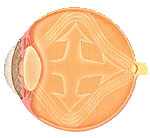Glaucoma
Your eye has pressure just like your blood vessels, and when this intraocular pressure(IOP) increases to dangerous levels, it damages the optic nerve. This can result in decreased peripheral vision and, eventually, blindness. Glaucoma is similar to ocular hypertension but with accompanying optic nerve damage and vision loss.
Glaucoma affects an estimated 3 million Americans, with 120,000 blind due to the condition. Elsewhere in the world, glaucoma treatment is less available, and glaucoma ranks as a leading cause of blindness throughout the world. Severe visual impairment and even blindness can occur if the glaucoma is left untreated. There are two major types of glaucoma: chronic or primary open-angle glaucoma (POAG) and acute closed-angle glaucoma. Other variations include congenital glaucoma, pigmentary glaucoma and secondary glaucoma.
Great River Eye Recommendations for Glaucoma Care

Glaucoma Signs and Symptoms
Chronic glaucoma (primary open-angle glaucoma or POAG) is often called "the silent thief of sight " because you have no warning sign, no hint that anything is wrong. About half of Americans with chronic glaucoma don't know they have it. Glaucoma gradually reduces your peripheral vision, but by the time you notice it, permanent damage has already occurred. If your IOP remains high, the destruction can progress until tunnel vision develops, and you will only be able to see objects that are straight ahead.
An acute attack of narrow-angle glaucoma, also termed acute angle-closure glaucoma or acute closed-angle glaucoma, produces sudden symptoms such as eye pain, headaches, haloes around lights, dilated pupils, vision loss, red eyes, nausea and vomiting. These signs may last for a few hours, subside, then return again for another round. Each attack takes with it part of your field of vision.
Other signs include headaches, blurred vision, difficulty adapting to darkness, or haloes around lights. Chronic glaucoma normally develops after age 35, but can occur at any age.
Like POAG, normal-tension glaucoma (also termed normal-pressure glaucoma, low-tension glaucoma or low-pressure glaucoma) is an open-angle type of glaucoma that can cause visual field loss due to optic nerve damage, but in normal-tension glaucoma, the eye's IOP remains in the normal range.
Chronic narrow-angle glaucoma, like open-angle glaucoma, can be symptomless until vision loss occurs.
Acute angle-closure glaucoma is a medical emergency. If the high pressure is not reduced within hours, it can permanently damage vision. Anyone who experiences its symptoms should immediately contact an ophthalmologist or go to a hospital emergency room.
It's difficult to spot signs for congenital glaucoma because the children are too young to understand. If you notice a cloudy, white, hazy, enlarged or protruding eye, consult your eye doctor. Congenital glaucoma occurs more in boys than girls.
Pigmentary glaucoma often exhibits no symptoms at all. You may notice some pain and blurry vision after exercise. Pigmentary glaucoma affects mostly white males in their mid-30s to mid-40s.
Symptoms of chronic glaucoma following an eye injury could indicate secondary glaucoma.

Great River Eye Clinic Recommendations for Glaucoma Care
1. Annual Eye Exams for all patient 40 or older; to include:
A. Intraocular Pressure
B. Dilated funus exam
C. Evaluation of optic nerve, cup/disc ratio
2. If there is a family history of glaucoma, annual eye exams for all patients age 30 or older; to include:
A. Intraocular Pressure
B. Dilated funus exam
C. Evaluation of optic nerve, cup/disc ratio
3. For patients who are glaucoma suspects (intraocular pressure elevated and/or suspicious cup/disc ratio), eye exams every six months to include:
A. Intraocular Pressure
B. Dilated funus exam
C. Evaluation of optic nerve, cup/disc ratio
D. Visual field at least annually
- Specialized testing which maps peripheral vision a nd visual sensitivity.
E. Retinal Tomography at least annually
- Evaluation to detect glaucoma and/or progression of glaucoma damage.
F. Pachymetry
- Ultrasound measurement of corneal thickness for ocular pressure.
4. For patients who have glaucoma: eye exams every 3-6 months or more frequently if glaucoma is not adequately controlled:
A. Intraocular pressure
B. Dilated funus exam
C. Evaluation of optic nerve, cup/disc ratio
D. Visual field at least annually
E. Retinal Tomography at least annually
|

![]()
![]()










